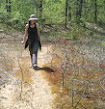Seed Collection Workshop
The High Park Volunteer Stewardship Program has a very special Seed Collection Workshop on October 18th with Gavin Trevelyan, Coordinator for Tallgrass Ontario who will instruct us in the techniques and science behind the efficient and ethical collection of tallgrass prairie plant seed.
Spend a day in the lovely High Park Black Oak Savannah, while acquiring a new skill and making new acquaintances. Help out in the ongoing effort to restore and protect Ontario's threatened tallgrass prairies and savannas.
Meet at 10:30 am in front of the Grenadier Restaurant and we will then go to the Training Centre (or work site). Later on, we will proceed out to the Black Oak Savanna for a hands-on seed collection event. Dress for the weather, rain or shine! Admission is free. Space in this workshop is limited so please RSVP if you wish to attend the workshop. A second seed cleaning workshop may be held in the future if there are enough people wanting one.
I also like An Introduction to Tallgrass Prairie in Southern Ontario. It's written by a former grad student of Larry Lamb's at U. of Waterloo, and yes the spelling needs editing (either get over it or volunteer to fix it?) but it's worth keeping around because he makes some essential concepts easy to understand. For example:
Savannah
Savannah is an ecosystem where scattered trees contribute only 10% to 50% canopy cover. The trees are widely spaced due to competition for moisture and nutrients. In a continuum of ecosystem delineation determined by an increasing requirement for moisture, savannah is the ecosystem that is situated between tallgrass prairie and oak forest. Since the two ecosystems are contiguous, the interdegration between species can be pronounced. As a result of the minimal canopy closure and the resulting abundant sunlight the majority of the understory species are species of the tallgrass prairie. There are however species that are truly associated with savannah. The classic indicator being the False Foxgloves Aureolaria spp. [check out this Downy False-foxglove species report.]
In addition to oak savannah in Ontario, there are also limited areas of cedar savannah in Southwestern Ontario and aspen parkland in Northwestern Ontario.
Savannah is a far more restricted community than prairie in Ontario. This fascinating community is worth of a website of its own.
*
Update: since we're talking about the historic/rockstar moments in prairie restoration ecology, here's a seminal one I never knew. It's earlier than I would've guessed, even has Ontario connection too:
"Theodore M. Sperry was born in Toronto, Ontario, in 1907. After completing a B.S. in 1929 at Butler University in his hometown of Indianapolis, Indiana, he entered the graduate school of the University of Illinois, where he earned an M.S. in 1931 and a Ph.D. in Botany in 1933. In that same year, Ecology published a condensed version of his dissertation about root systems of prairie plants. At the University of Wisconsin, Aldo Leopold read the article and arranged for Sperry’s transfer to the Civilian Conservation Corps under the National Park Service in Madison, Wisconsin. Under the auspices of Leopold, Sperry was given sixty acres of old farm land near the Madison campus on the University’s research land. Sperry and a small crew were given long-handled shovels and a truck and told to “go make a prairie.” Curtis Prairie became the world’s first restored prairie, and Sperry considered his work and research at Curtis Prairie his greatest professional achievement.
-SERNews, The Newsletter of the Society for Ecological Restoration International Volume 23 No. 3 (October 23 2009)



1 comment:
Oh, I wish I'd checked my blog earlier. Unfortunately, I wouldn't have been able to get there, but I could have passed the info along.
Post a Comment